Urban Trees: Lifelines for Endangered Species in 2024
Introduction
In the hearts of our bustling cities, a quiet revolution is taking place. Urban trees, often overlooked and underappreciated, are emerging as crucial allies in the survival of endangered species. As we navigate the challenges of biodiversity loss in 2024, these leafy sentinels are proving to be more than just scenery—they’re lifelines for countless at-risk creatures.
The Hidden Ecosystems in Urban Trees
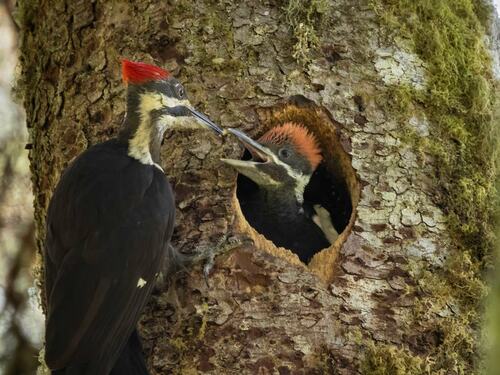
A Woodpecker Feeds its Chick in a Tree Cavity
When you walk down a tree-lined street, you’re passing by entire ecosystems hidden in plain sight. Urban trees are teeming with life, hosting a surprising diversity of species within their branches, leaves, and bark.
Microhabitats: Nature’s High-Rises
Urban trees provide a variety of microhabitats, each supporting different species:
- Cavities in trunks serve as nesting sites for birds and small mammals.
- Bark crevices house insects and spiders.
- Canopies offer shelter for birds and arboreal mammals.
These microhabitats are crucial for biodiversity, especially in areas where natural habitats are scarce. For instance, oak trees can support up to 2,300 different species. The complexity of these microhabitats increases with the age and size of the tree. Older trees often develop hollows, dead branches, and intricate bark patterns that provide specialized niches for various species. This highlights the importance of preserving mature trees in urban environments, as they offer unique habitats that younger trees cannot replicate.
City Trees vs Rural Trees: A Biodiversity Showdown
Surprisingly, urban trees often support a higher diversity of species than their rural counterparts. This phenomenon, known as the “urban biodiversity paradox,” highlights the unexpected role cities can play in conservation efforts.
Factors contributing to urban tree biodiversity:
- Diverse tree species in cities provide varied habitats.
- Urban heat island effect attracts certain species.
- Less competition from dominant species in fragmented urban habitats.
A study in the Journal of Applied Ecology found that urban areas can support up to 20 percent more bird species than nearby rural areas, largely thanks to the diversity of urban trees.
This biodiversity advantage extends beyond birds. Urban areas often host a wider variety of plant species due to intentional planting and accidental introductions. This floral diversity, in turn, supports a broader range of insect pollinators and herbivores, creating complex urban food webs that can rival or exceed those in rural areas.
Endangered Species Thriving in City Canopies
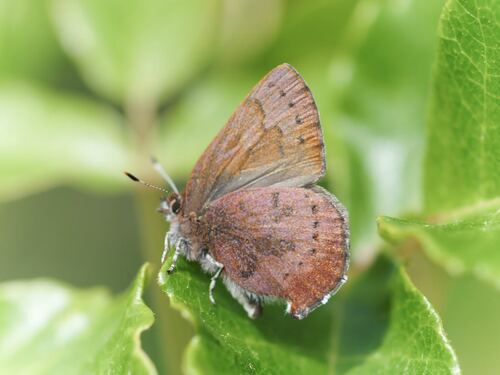
A San Bruno Elfin Butterfly Rests on a Leaf
Urban trees are becoming unexpected sanctuaries for endangered species. From rare birds to elusive insects, these city dwellers are finding refuge in the most surprising places.
Success Stories: Birds Taking Flight in Urban Forests
Black-capped Vireo
The black-capped vireo , once on the brink of extinction, has found an unlikely haven in the green spaces of Austin and other Texas cities. Urban parks and preserves, with their mix of open areas and dense vegetation, mimic the bird’s natural habitat.
The success of the black-capped vireo in urban environments demonstrates the potential for city planning to actively support endangered species. By designing parks and green spaces that incorporate the specific habitat requirements of target species, cities can play a crucial role in conservation efforts.
Peregrine Falcons
Peregrine falcons have made a dramatic comeback in urban environments. These raptors have adapted remarkably well to city life, using tall buildings as substitutes for their natural cliffside nests and urban trees as hunting perches.
The peregrine falcon’s urban success story highlights the adaptability of some species to human-modified environments. Their presence in cities not only aids in their conservation but also provides natural pest control, as they prey on pigeons and other urban birds.
Insects: Tiny Treasures in City Trees
Urban trees are vital for endangered insects:
San Bruno Elfin Butterfly
The San Bruno elfin butterfly, found only in the San Francisco Bay Area, has benefited from the incorporation of its host plant, Pacific sedum, into urban landscaping projects.
This case demonstrates how targeted urban planning and landscaping can support highly specialized endangered species. By incorporating specific plant species into urban green spaces, cities can create microreserves for endangered insects and other small creatures.
Stag B eetles
In Europe, ” stag beetle loggeries “—piles of partially buried logs in city parks—provide ideal habitats for these threatened insects and support a whole community of wood-dwelling organisms.
The creation of stag beetle loggeries shows how urban conservation can go beyond preserving existing habitats to actively creating new ones. This approach can be adapted for various species, turning urban green spaces into biodiversity hotspots.
Plant Power: Urban Trees Supporting Endangered Flora
It’s not just animals benefiting from urban trees. Endangered plants are finding unlikely homes in city environments:
- The Wollemi pine , thought extinct until 1994, is now being planted in botanic gardens and urban parks worldwide.
- Many orchid species, traditionally forest dwellers, are adapting to life on urban trees.
Urban environments can serve as ex-situ conservation sites for endangered plants. City botanical gardens and parks can act as living gene banks, preserving plant species that are threatened in their native habitats. This not only aids in conservation but also raises public awareness about endangered species.
The Connectivity Factor: Urban Trees as Wildlife Corridors
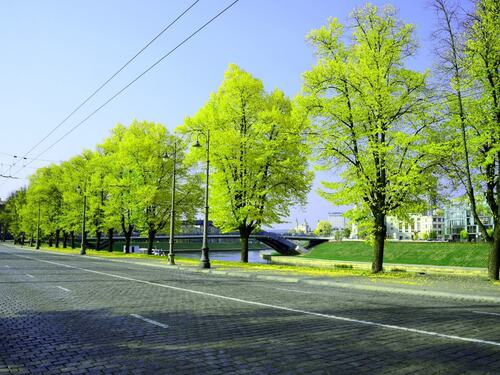
Lush Green Trees Line a City Street
Urban trees play a crucial role in connecting fragmented habitats, allowing species to move and thrive in otherwise inhospitable urban landscapes.
Tree-Lined Streets: Nature’s Highways
Tree-lined streets act as corridors for birds, insects, and small mammals:
- They provide safe routes for daily movement and seasonal migrations
- They allow for genetic exchange between populations
- They offer temporary shelter and food sources
Research has shown that streets with 30 percent or more canopy cover can significantly increase the movement of native bird species through urban areas.
These green corridors are essential for maintaining genetic diversity in urban wildlife populations. They allow animals to move between larger green spaces, reducing the risk of inbreeding and helping populations remain resilient in the face of environmental changes.
Stepping Stones: Urban Forests Bridging the Gap
Urban forests and parks serve as stepping stones between larger natural areas:
- They provide temporary habitats for migrating species
- They allow for the spread of plant species through seed dispersal
- They act as refuges during extreme weather events
A study in Scientific Reports found that urban green spaces as small as fifty to sixty hectares can serve as effective stepping stones for migratory birds.
These urban stepping stones are particularly crucial for long-distance migratory species. As natural habitats become increasingly fragmented by human development, urban green spaces can provide critical rest and refueling stops for birds on their long journeys.
Challenges Faces by Urban Trees and Their Inhabitants

Workers Using Utility Trucks to Perform Street Maintenance – Photo by Wolfgang Weiser
While urban trees offer hope for endangered species, they face numerous challenges in city environments.
The Air We Breathe: Pollution’s Impact
Air pollution poses significant threats to urban trees and their inhabitants:
- Ozone damage to leaves reduces trees’ ability to photosynthesize.
- Particulate matter can clog leaf stomata, affecting tree health.
- Pollutants can accumulate in tree tissues, potentially harming wildlife.
Despite these challenges, many tree species show remarkable resilience to urban pollution. Some species even help mitigate air pollution by trapping particulates on their leaves and absorbing gaseous pollutants. This dual role—as both victims and mitigators of pollution—underscores the complex relationship between urban trees and their environment.
Concrete Jungles: Urban Development Threats
Urban development continues to put pressure on city trees:
- Construction often results in tree removal or damage.
- Soil compaction from foot traffic and vehicles harms root systems.
- Underground utility work can severely damage tree roots.
The loss of mature trees to development is particularly concerning, as these trees provide the most valuable habitats for wildlife. Balancing urban growth with tree preservation is a key challenge for city planners and conservationists.
Conservation Efforts: Protecting Urban Trees for Endangered Species
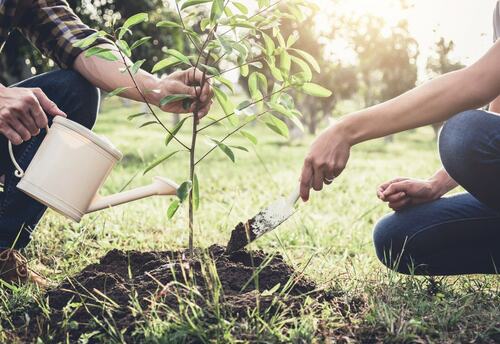
Two People Care for a Newly Planted Tree
Despite these challenges, cities worldwide are taking steps to protect and enhance their urban forests.
Green Initiatives: Cities Taking Action
Many cities are implementing tree planting and preservation programs:
- New York City’s MillionTreesNYC initiative reached its goal of planting one million new trees by 2015.
- Melbourne’s “Urban Forest Strategy” aims to increase canopy cover to 40 percent by 2040
- Singapore’s “City in a Garden” vision integrates greenery into urban planning
These initiatives not only increase urban tree cover but also focus on creating diverse, resilient urban forests that can support a wide range of species.
Community Power: Getting Involved in Urban Forest Management
Community involvement is crucial for the success of urban tree initiatives:
- Volunteer tree planting events
- Citizen science projects to monitor urban wildlife
- Community gardens and green space adoption programs
Engaging local communities in urban forest management creates a sense of ownership and stewardship, ensuring the long-term success of conservation efforts.
Tech to the Rescue: Innovative Monitoring Solutions
New technologies are helping to monitor and protect urban biodiversity:
- Satellite imagery for mapping urban tree cover
- AI-powered acoustic monitoring for urban wildlife
- Smartphone apps for citizen reporting of tree health and wildlife sightings
These technological solutions enable more efficient and comprehensive monitoring of urban ecosystems, allowing for data-driven conservation strategies.
The Future of Urban Trees in Endangered Species Conservation
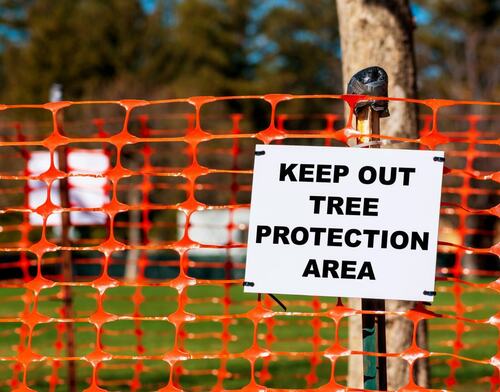
A Temporary Fence Protects Trees from Construction Vehicles
As we look to the future, urban trees are set to play an even more significant role in conservation efforts.
Growing Green: Predictions for Urban Forests
Experts predict a growing emphasis on urban forestry, including:
- Increased investment in green infrastructure
- More stringent tree protection laws in urban areas
- Integration of urban forest management into city planning
As cities expand and densify, innovative approaches like vertical forests and rooftop gardens may become more common, creating new habitats for wildlife in unexpected places.
Cutting-Edge Research: New Frontiers in Urban Biodiversity
Emerging research is shedding light on the complex relationships between urban trees and biodiversity:
- Studies on the genetic adaptation of species to urban environments
- Research into the role of urban trees in carbon sequestration and climate change mitigation
- Investigations into the health benefits of urban green spaces for both wildlife and humans
This research will inform future urban planning and conservation strategies, helping to create cities that are more hospitable to both humans and wildlife.
Rewilding Cities: A Bold Vision for Urban Conservation
Urban rewilding projects are gaining traction worldwide, including:
- Creation of urban nature reserves
- Reintroduction of native species to city environments
- Transformation of abandoned urban areas into wildlife habitats
These projects represent a paradigm shift in urban ecology, viewing cities not as separate from nature, but as part of it.
Conclusion
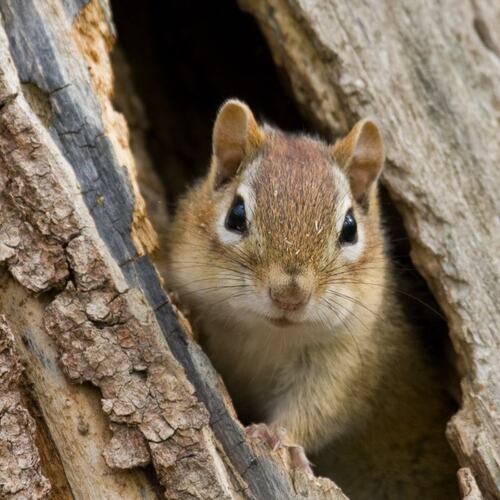
A Chipmunk Peeks out from its Nest
Urban trees are vital lifelines for endangered species in our increasingly urbanized world. By supporting urban tree initiatives and appreciating every tree in our neighborhoods, we can all contribute to biodiversity conservation. As we face changing weather patterns and habitat loss, urban trees stand as beacons of hope.
If you’re in the San Francisco Bay area, contact Arborist Now today for expert advice. Together, we can keep our cities green and preserve the incredible diversity of life on our planet for generations to come.


